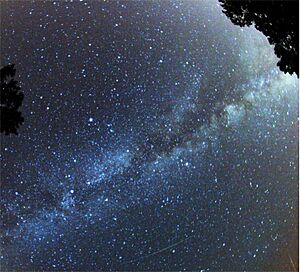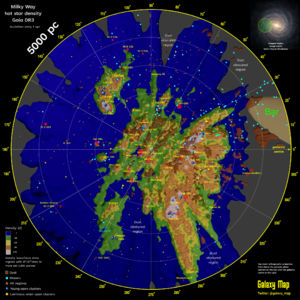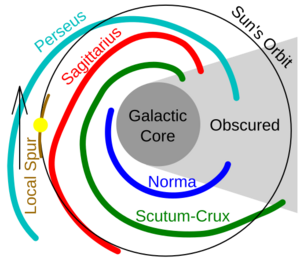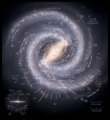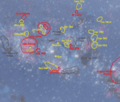Milky Way facts for kids
The Milky Way is the amazing galaxy we call home! It's a huge collection of stars, gas, and dust, all held together by gravity. Our own Sun and its Solar System are just a tiny part of it.
The Milky Way has over 200 billion stars. It looks like a flat disk with a bulge in the middle, and it has spiral arms. Imagine a giant cosmic pinwheel! From Earth, we see it as a faint band of light across the night sky.
Our galaxy is about 100,000 light years wide. A light-year is how far light travels in one year, which is a really, really long distance! The Milky Way is a type of galaxy called a barred spiral galaxy.
It's part of a group of galaxies called the Local Group. This group includes three large galaxies and more than 50 smaller ones. The Milky Way is the second largest in this group, right after the Andromeda Galaxy. Our closest neighbor is the Canis Major Dwarf galaxy, about 25,000 light-years away.
Did you know the Andromeda Galaxy is actually moving towards us? In about 3.75 billion years, it will meet the Milky Way! It's moving super fast, about 1,800 kilometres every minute.
Contents
What's in the Milky Way?
The Milky Way has three main parts:
- The disk: This is where our Solar System is located. It's a flat, thin part with spiral arms.
- The bulge: This is a thick, round part at the very center of the galaxy.
- The halo: This is a large, faint area that surrounds the disk and bulge. It contains older stars and dark matter.
The Milky Way's Name: A Myth
The name "Milky Way" comes from an old Greek mythology story. In this myth, the powerful god Zeus wanted his baby son, Heracles, to become immortal. Heracles' mother was a human woman.
So, Zeus secretly placed baby Heracles on the goddess Hera's breast while she was sleeping. He hoped the baby would drink her special divine milk. But Hera woke up and was surprised to find a baby she didn't know! She pushed him away, and a stream of her milk sprayed across the night sky. This spray of milk created the faint, glowing band of light we now call the Milky Way.
Discovering Our Galaxy

For a long time, people didn't know what the Milky Way really was.
- In 1610, Galileo Galilei used a telescope to look at the Milky Way. He was the first to see that it was made up of countless faint stars!
- In 1755, a thinker named Immanuel Kant suggested that the Milky Way might be a huge, spinning group of stars, held together by gravity. He also wondered if other fuzzy patches in the sky, called "nebulae," might be other galaxies, like islands in space.
- In 1785, William Herschel tried to map the shape of the Milky Way. He counted stars in different parts of the sky and drew a picture of what he thought our galaxy looked like. He believed our Solar System was close to the center.
- In the early 1900s, scientists like Jacobus Kapteyn, Bertil Lindblad, and Jan Oort studied how stars move. They realized that our galaxy was actually spinning!
Proving Other Galaxies Exist
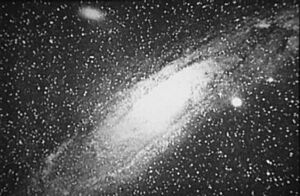
For many years, scientists debated if the "spiral nebulae" were part of our Milky Way or if they were separate galaxies far away.
- In 1917, Heber Doust Curtis studied a star that exploded (a "nova") in the "Great Andromeda Nebula." He noticed these explosions were much fainter than those in our own galaxy. This made him think Andromeda was very far away and a separate galaxy.
- The big debate was finally settled in the 1920s by Edwin Hubble. He used a powerful telescope to look at the Andromeda Nebula. He found special stars called Cepheid variables, which helped him figure out distances. Hubble proved that Andromeda was incredibly far away – too far to be part of the Milky Way. This showed that "spiral nebulae" were indeed other "island universes," or galaxies!
Mapping the Milky Way from Space
Today, we have amazing spacecraft helping us map our galaxy.
- The ESA's Gaia spacecraft is creating the most accurate 3D map of the Milky Way ever! It measures the distances to billions of stars, helping us understand our galaxy's size, shape, and how it moves.
How Big is the Milky Way?
The main part of the Milky Way's disk is about 100,000 light-years across. It's roughly 1,000 light-years thick.
- Scientists think it has at least 200 billion stars, and maybe even up to 400 billion! It's hard to count all the tiny, faint stars.
- For comparison, our neighbor, the Andromeda Galaxy, might have a trillion (1,000 billion) stars!
- The number of stars slowly decreases as you move away from the center. Beyond about 40,000 light-years, the number of stars drops much faster, and scientists are still trying to understand why.
Beyond the stars, there's also a very thick disk of gas. Recent studies show this gas disk is about 12,000 light-years thick, which is twice what we thought before!
To help you imagine the size: if our entire Solar System (out to Pluto) was shrunk to the size of a US quarter coin (about 25 mm), the Milky Way would be 2,000 kilometers wide!
Our Solar System travels around the center of the galaxy at about 220 kilometers per second. It takes us about 240 million years to complete one full trip around the galaxy! This is called a galactic year.
The Milky Way also has a huge, faint Galactic halo that extends far out. Its size is limited by the orbits of two smaller galaxies that orbit the Milky Way: the Large and Small Magellanic Clouds.
The Galactic Center
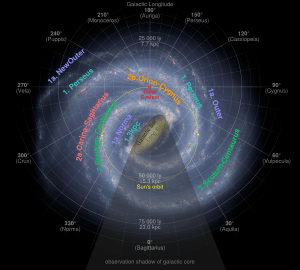
The very center of the Milky Way is a busy and mysterious place!
- The galactic disk bulges outward at the center, forming a thick central region.
- Our Sun is about 25,000 to 28,000 light-years away from the galactic center.
- Scientists have observed that things move very fast around the galactic center. This means there must be something incredibly massive there.
- It's now confirmed that the center of the Milky Way holds a supermassive black hole called Sagittarius A*. Most large galaxies are believed to have one of these giant black holes at their heart!
- The Milky Way also has a "bar" shape in its center, which is a long, stretched-out group of stars. This bar is thought to be the brightest feature of our galaxy if you could see it from another galaxy like Andromeda.
Images for kids
-
A view of the Milky Way toward the constellation Sagittarius (including the Galactic Center), as seen from a dark site with little light pollution (the Black Rock Desert, Nevada), the bright object on the lower right is Jupiter, just above Antares
-
Photograph of the "Great Andromeda Nebula" from 1899, later identified as the Andromeda Galaxy
-
Map of the Milky Way Galaxy with the constellations that cross the galactic plane in each direction and the known prominent components annotated including main arms, spurs, bar, nucleus/bulge, notable nebulae and globular clusters.
-
Artistic close-up of the Orion Arm with the main features of the Radcliffe Wave and Split linear structures, and with the Solar System surrounded by the closest large scale celestial features at the surface of the Local Bubble at a distance of 400–500 light years.
-
The structure of the Milky Way is thought to be similar to this galaxy (UGC 12158 imaged by Hubble)
-
360-degree panorama view of the Milky Way (an assembled mosaic of photographs) by ESO, the galactic centre is in the middle of the view, with galactic north up
-
360-degree rendering of the Milky Way using Gaia EDR3 data showing interstellar gas, dust backlit by stars (main patches labeled in black; white labels are main bright patches of stars). Left hemisphere is facing the galactic center, right hemisphere is facing the galactic anticenter.
-
Galaxy rotation curve for the Milky Way – vertical axis is speed of rotation about the galactic center; horizontal axis is distance from the galactic center in kpcs; the sun is marked with a yellow ball; the observed curve of speed of rotation is blue; the predicted curve based upon stellar mass and gas in the Milky Way is red; scatter in observations roughly indicated by gray bars, the difference is due to dark matter
-
The Milky Way arching at a high inclination across the night sky, (this composited panorama was taken at Paranal Observatory in northern Chile), the bright object is Jupiter in the constellation Sagittarius, and the Magellanic Clouds can be seen on the left; galactic north is downward
See also
 In Spanish: Vía Láctea para niños
In Spanish: Vía Láctea para niños


